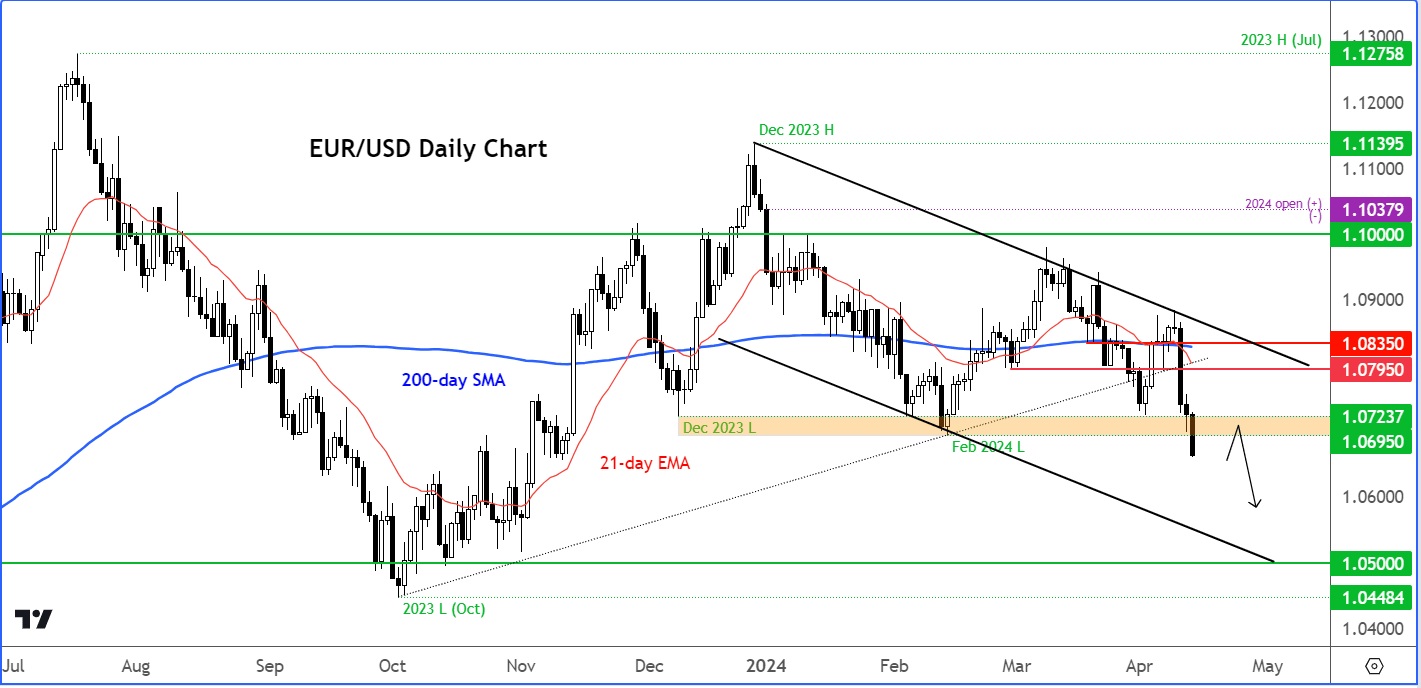 In a recent analysis, Fawad Razaqzada, Market Analyst at City Index, notes a growing bearish trend in the EUR/USD currency pair. This week witnessed significant developments as the EUR/USD broke below crucial support levels, including 1.0795 initially, followed by a pivotal range spanning from 1.0695 to 1.0725. This particular range had served as substantial support in December and February, underscoring the significance of the recent breach.
In a recent analysis, Fawad Razaqzada, Market Analyst at City Index, notes a growing bearish trend in the EUR/USD currency pair. This week witnessed significant developments as the EUR/USD broke below crucial support levels, including 1.0795 initially, followed by a pivotal range spanning from 1.0695 to 1.0725. This particular range had served as substantial support in December and February, underscoring the significance of the recent breach.
Technical Indicators Point Bearish
Adding to the bearish sentiment, the EUR/USD also breached its bullish trend line established since October. Moreover, the 21-day exponential moving average has now dipped below the 200 simple moving average, signaling further bearishness. The price action residing below these moving averages suggests a clear downward trajectory in the near term.
Anticipated Price Movements
Considering these developments, analysts anticipate a potential drop in the EUR/USD towards the 1.06 handle initially, with further downside targets at 1.05 and possibly a test of the October low at 1.0448 thereafter. On the upside, the broken support-turned-resistance zone between 1.0695 to 1.0725 presents a significant barrier. Beyond this, resistance levels at 1.0795 and 1.0835 are expected, based on previous support levels.
Factors Driving Pressure on the Euro
The euro faces mounting pressure amid a widening gap between expected rate cuts by the Federal Reserve (Fed) versus the European Central Bank (ECB). While the ECB appears poised for interest rate cuts, the Fed’s timeline for such actions is extending. This divergence in rate paths has contributed to the euro’s decline, with the EUR/USD probing its lowest levels since mid-November.

Market Outlook and Economic Calendar
Looking ahead, the US economic calendar includes key events such as the University of Michigan surveys and speeches from several Fed officials. However, significant US macro data is not expected until late April when the Fed’s preferred inflation gauge is released. In the interim, the US dollar may find support on short-term dips, fueled by positive rate outlooks compared to other central banks such as the ECB and Bank of Canada (BOC).
Root Causes of Euro Weakness
Eurozone’s weak economic performance and subdued inflationary pressures have intensified calls for rate cuts by the ECB. ECB President Christine Lagarde recently acknowledged the possibility of a rate reduction in June, with Bloomberg reporting that up to five ECB Governing Council members advocated for a rate cut at a recent meeting. Speculation suggests the potential for a 100 basis points reduction in the deposit rate from its current 4%.
Inflationary Pressures and Economic Conditions
Meanwhile, the US dollar’s strength is bolstered by persistent inflationary pressures and robust economic data, including a notable uptick in Consumer Prices in March. Rising prices across various sectors, including car insurance, transportation, and healthcare services, have contributed to inflationary concerns. In contrast, the Eurozone’s economic sluggishness and subdued price pressures have amplified calls for ECB intervention, further exacerbating the euro’s decline against the US dollar.




